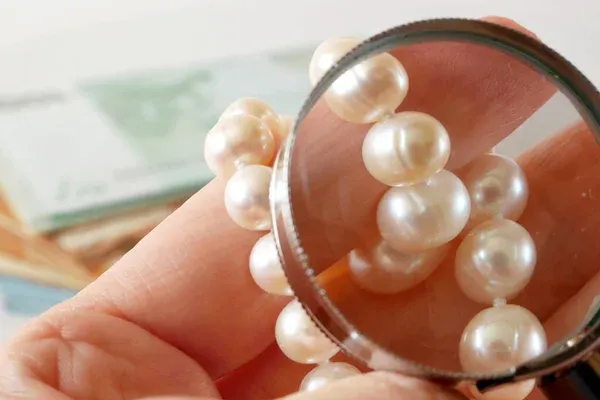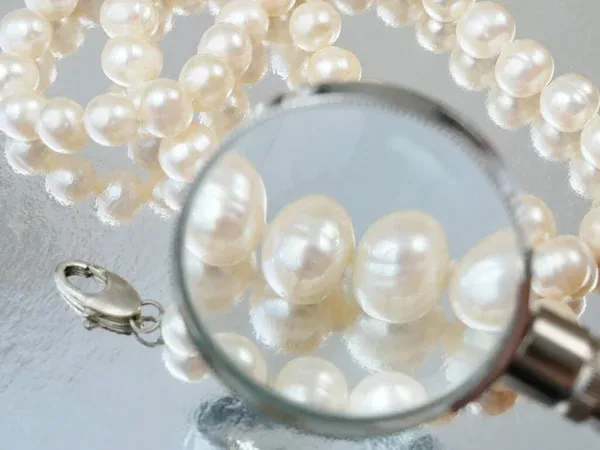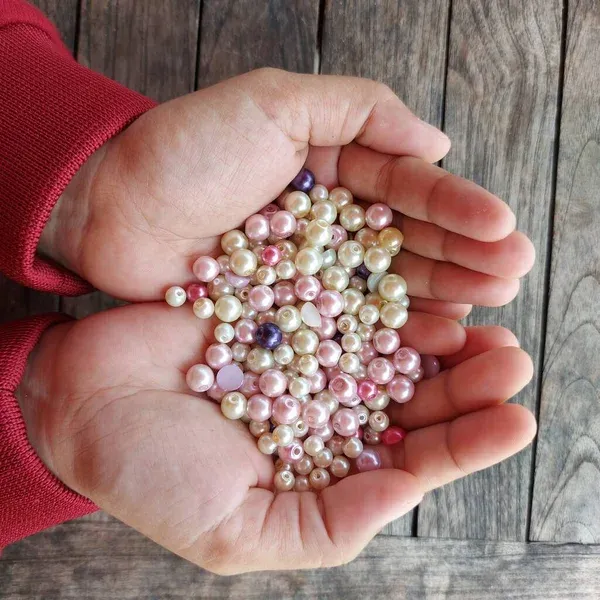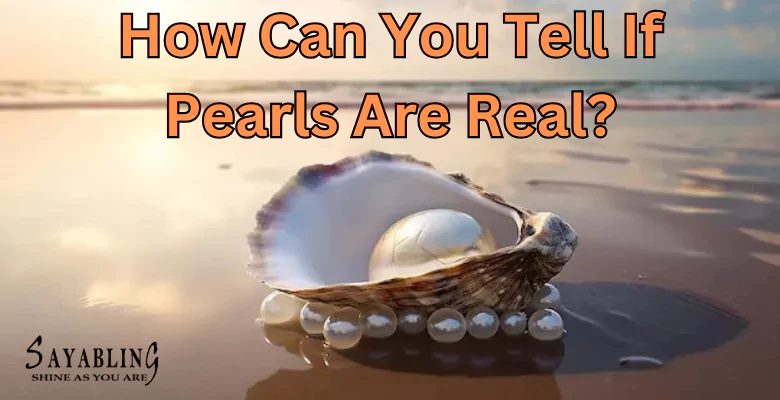Pearls, with their timeless beauty and natural elegance, have captivated people for centuries. But with the market flooded with fake pearls, it can be challenging to distinguish between real pearls and their artificial counterparts. Whether you’re looking to buy pearls or simply curious about the authenticity of the ones you own, this guide will help you identify the difference between genuine pearls and fakes.
How do you know if your pearl is real? there are some easy and simple methods mentioned next in the blog for determining if your pearls are the real deal. But the simplest way to tell if a pearl is natural or fake is to rub it against the edge of your teeth. A real pearl will feel gritty, while a fake will be very smooth. But that’s just one of so many methods for figuring out if you have a real pearl or a fake pearl.
The Difference Between Real Pearls Vs. Fake Pearls

What are real pearls?
A real pearl is produced by pearl-bearing oysters in fresh or salt water. It can be either cultured or natural, depending on human intervention. Almost all pearls on the market today are cultured, as natural pearls formed without human assistance are extremely rare and typically found only in museums. So, when you hear “natural pearls” in a store, it usually means they are real, not fake.
What are fake pearls?
Imitation or fake pearls are man-made, often from materials like glass, plastic, alabaster, or shells coated to resemble real pearls. While some fakes are easily identifiable, others can closely mimic the appearance of genuine pearls. The most famous imitation, Majorica pearls made from glass, can often deceive the eye due to their realistic look.
How to Identify Real Pearls?

The Tooth Test
One of the easiest and most commonly used methods to test pearls is the tooth test. If you are curious that how to tell if pearls are real with your teeth? Take the pearl and gently rub it along the surface of your front teeth. Be sure not to bite down or use too much pressure.
Real pearls will feel slightly gritty or rough due to the layers of nacre, the substance that forms around a pearl’s nucleus. Fake pearls, often made from glass or plastic, will feel perfectly smooth and polished.
Examine the Surface
Another quick way to check if your pearls are real is by visually inspecting them for imperfections. Nature isn’t perfect, and neither are real pearls. Genuine pearls tend to have tiny imperfections, bumps, or ridges on their surface. Their shine (known as “luster”) also tends to be more soft and deep, almost glowing from within. Fake pearls, on the other hand, will usually have a flawless, smooth surface. The luster will appear more superficial, with an almost plastic-like sheen.
The Weight Test
Genuine pearls have a more substantial weight compared to fakes. Due to the dense nacre layers, real pearls will often feel heavier in the hand compared to imitation pearls of the same size. Fake pearls, especially those made from plastic or lightweight materials, will feel surprisingly light.
If you have a strand of pearls, hold them in your hand to assess their weight. This can give you a quick indication of their authenticity.
The Temperature Test
The temperature test is another easy and effective method to determine if pearls are real. When you first pick up a real pearl, it will feel cool to the touch. As you hold it, it will gradually warm up to match your body temperature. Imitation pearls made of plastic or glass may feel warm from the start and won’t have the same cooling sensation as genuine pearls.
The Drill Hole Inspection
If you’re dealing with a string of pearls, take a closer look at the drill holes (the holes through which the string passes). The holes in genuine pearls are typically small, and you may notice slight chipping around the edges, which is normal due to the natural material.
Imitation pearls often have larger, more uniform holes. You might also see flaking or peeling around the hole, particularly if the pearl coating is applied to a bead underneath.
The Magnification Test
Use a magnifying glass or jeweler’s loupe to get a closer look at the pearls. Under magnification, real pearls will reveal a complex, layered structure of nacre. You may also spot small irregularities or ridges. Imitation pearls often show uniformity under magnification, with a smooth, almost glass-like surface and no nacre layers.
The X-Ray Test
This is a professional method that requires the help of a jeweler or gemologist. Using an X-ray machine, a professional can determine the internal structure of the pearl. Natural and cultured pearls will show concentric growth rings and a more organic structure inside. Fake pearls will appear solid or reveal an obvious bead in the center.
The Bounce Test
If you have a loose pearl (not in jewelry), try the bounce test. When dropped onto a glass surface, a real pearl will bounce back slightly, due to its dense nacre layers. Fake pearls often bounce less or sound different when they hit the surface.
How to Spot Real Pearls?

Real pearls are a classic that deserves a place in every jewelry box. But how can you tell if your pearls are real? You should know that real pearls can be either freshwater or saltwater (sea) pearls. The difference is in how they’re grown, their shape, and of course their price. Today virtually all real pearls are cultured artificially by seeding but it still takes several years before they are formed.
- Imperfections: Real pearls have slight flaws, uneven surfaces, and varied luster. In a real pearl necklace, each pearl is unique, while fakes tend to be uniform.
- Shape: Freshwater pearls come in various shapes; saltwater pearls are more round but still not perfect. Uniform, round pearls at a low price are likely fake.
- Overtone: Real pearls have subtle color variations and overtones, while fakes are uniformly colored. Odd colors may indicate dyed or fake pearls.
- Size: Large pearls (10 mm+) are rare and expensive. Be wary of unusually large pearls at low prices.
- Weight: Real pearls are heavier than plastic fakes, though glass imitations can feel similar in weight.
- Drill Hole: Real pearls have small, clean drill holes. Fakes often have larger holes, and the coating may show signs of peeling.
- Temperature: Real pearls feel cool to the touch and warm up as you hold them.
- Luster: Real pearls have deep, varied luster, while fake pearls have a glassy, uniform shine.
- Price: Real pearls vary in cost based on size, shape, and luster. Cheaper pearls are often smaller or irregular, while perfect, round pearls command higher prices.
Trusting the Experts
While many of these tests can be done at home, it’s always best to consult a professional jeweler if you’re still unsure about your pearls. Jewelers have specialized equipment and experience to provide a definitive answer regarding authenticity.
Whether you’re examining a family heirloom or shopping for new pearls, knowing how to distinguish real pearls from fakes can give you confidence in your purchase or inheritance. And with these simple tests, you’ll be well on your way to becoming a pearl expert yourself!
Remember, real pearls have a natural, organic beauty that fake pearls just can’t match. Their subtle imperfections, weight, and luminous luster are what make them truly special.
Conclusion
To identify the real pearls, look for slight imperfections in their surface and luster, as genuine pearls are naturally unique. Freshwater pearls vary in shape, while saltwater pearls tend to be round but never perfectly so.
Real pearls are heavier than plastic fakes, and though glass imitations may match their weight, the coolness to the touch and gradual warming is a key indicators of authenticity. Real pearls have natural variations, while fakes are uniformly colored.
Additionally, real pearls have a deep, varied luster that fakes lack. The price of real pearls reflects their rarity and quality, with larger, more perfect pearls commanding significantly higher costs, only consider a trusted retailer to buy a real pearl.
FAQ’s
Q.1: Are Black Pearls Real?
Yes, black pearls are real. Tahitian pearls, which are also called black pearls, have a natural black or dark gray body color. Black Akoya pearls as well as black Freshwater pearls, however, are dyed or irradiated to look black.
Q.2: How to Tell if Freshwater Pearls are Real?
Freshwater pearls are real and come in two types: tissue-nucleated and bead-nucleated. Tissue-nucleated pearls are formed using a piece of donor oyster tissue, resulting in off-round shapes. Bead-nucleated pearls, which are larger and can be perfectly round, start with a bead nucleus. Both types are grown in oysters left in lakes, rivers, and ponds. Freshwater pearls are valued for their natural pastel colors like pink, peach, white, and lavender, as well as their silky luster and vibrant overtones.
Q.3: How Can You Tell if Pearls Are Real by Rubbing Two Pearls Together?
When a real pearl is rubbed against another real pearl, a pearl powder is produced and a soft and unique sound is produced. If two fake pearls are rubbed against each other, the process is smooth, no powder is produced and a very slight sound is produced..
Q.4: How to Tell Real Pearls by Using Fire to Test Pearl Authenticity?
When you burn a real pearl mildly, the pearl remains shiny, and intact and produces no odor. If the flame is consistent for about 2 minutes, the pearl produces a pop sound. A fake pearl coming across a naked fire will produce a bad odor, and it loses its luster.
Q.5: How to Tell if Akoya Pearls are Real?
Akoya pearls are real, saltwater, bead-nucleated cultured pearls known for their bright, mirror-like luster. Typically white or creamy, they may also come in blue or yellow-gold with pink or green overtones. The rainbow-like orient seen in high-quality and valued for their perfectly round shape, Akoya pearls are especially admired in stud earrings. Unlike freshwater pearls, which have a slightly egg-shaped appearance, Akoya pearls are perfectly spherical, making it easy to distinguish genuine Akoya pearls from fakes.
